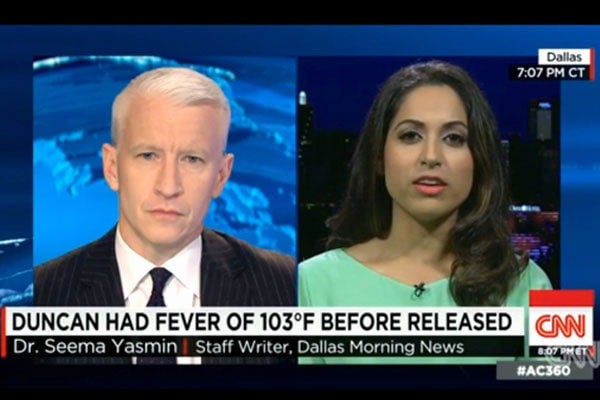
CNN medical analyst, Dallas Morning News reporter, Munk School graduate
Published: November 14, 2014
Since the Ebola outbreak in West Africa began, numerous commentators have appeared on television news shows to discuss the disease and its implications.
One of the most visible of those health experts has been Seema Yasmin who regularly appears on CNN to talk about Ebola and other health issues.
Dr. Yasmin is not only an epidemiologist at the University of Texas at Dallas and a journalist with the Dallas Morning News, she’s also a graduate of the Munk School’s fellowship in global journalism at the University of Toronto.
Recently, she spoke with writer Terry Lavender about Ebola, public health and journalism.
You are both a doctor and a reporter. Epidemiology and journalism seem like two separate worlds – why do these two fields interest you? Is there a connection between the two?
The connection is stories. Epidemiology is about connecting people’s stories and finding patterns in diseases. Journalism is the same.
Jeff Leen, the assistant managing editor in charge of The Washington Post’s investigations unit, told me that in regular journalism you’re looking for breaks in the pattern of daily life and investigative journalism looks for patterns in the breaks. Either way, you’re looking for patterns and stories and I love finding and sharing stories.
Being a doctor and an epidemiologist and a journalist gives me multiple licenses to be curious and to keep asking questions. I got told off as a child for asking too many questions but I won’t let anyone tell me off for it now! (Even though I do get the phone slammed down on me from time to time because of my questions.)
You have two jobs currently – you’re a staff writer at the Dallas Morning News and a professor of public health at the University of Texas Dallas. How do you balance those two roles?
It can be difficult when there is breaking news but for the most part we balance it well. I am obsessed with public health so I love teaching, especially my current students because they have very little prior experience of learning about public health.
You've been very busy since the Ebola outbreak – most notably as a commentator for CNN. How did that come about?
One of the first stories I wrote when I arrived in Dallas this summer was about the health of immigrant kids crossing the US-Mexico border. I interviewed multiple pediatric infectious disease experts who told me that disease outbreaks among these kids were unlikely given the high immunization rates in their home countries.
That story was picked up by producers at CNN who asked for an interview and it went from there to me signing on as a CNN medical analyst.
Do you consider yourself famous now? Do people recognize you on the street?
No! Only people who watch a lot of CNN.
Wolf Blitzer on CNN called you “a former CDC disease detective.” That sounds very glamorous. What was your role at the Center for Disease Control?
I was an officer in the Epidemic Intelligence Service investigating disease outbreaks. It was a fascinating and intense two years at the CDC and I loved every minute of it.
Although I enjoy fashion and glamour very much, being a disease detective was the antithesis of glamour. One of my first investigations was an epidemic of a deadly bacterial disease called Rocky Mountain Spotted Fever that involved me trekking across an American Indian reservation in Arizona pulling engorged ticks off stray dogs in the simmering heat. It was disgusting and depressing and at times it was terrifying but it was absolutely fascinating. It was my dream job.
As someone with one foot in the journalism field and one foot in the public health field, how do you feel about how the media has covered the Ebola outbreak? Are there lessons to be learned?
Brian Stelter asked me the same question on CNN’s Reliable Sources a few weeks ago and I told him that even in the midst of an Ebola outbreak here in Dallas, life was going on as usual. But the next day, a Dallas light rail station was shut down because a woman who was “being monitored for Ebola” had fallen sick at the station. I’m happy to say that the Dallas Morning News did not report that she was on any Ebola monitoring list but some news outlets did and it turned out to be untrue and caused a lot of panic.
This was a time when that old journalism maxim “it’s better to be late than wrong” was being repeated throughout our newsroom and I’m proud that even as we were covering breaking news in a story that was developing rapidly, we were very, very careful to be completely accurate.
You received your medical degree from Cambridge and have worked in a number of places around the world, including UCLA and Botswana before completing the Munk School of Global Affairs fellowship in global journalism. Why did you choose U of T?
I had so many stories to share – stories from being a doctor in London and Botswana and stories from investigating outbreaks. I wanted to learn how to be a better writer and I needed to learn the craft of journalism.
I knew the Munk School’s fellowship in global journalism would teach me that. But I had no idea the journalism program would also help me land a coveted spot as a newspaper writer at a time when these jobs are extremely hard to come by. I couldn’t be happier.
Terry Lavender writes about international affairs and global citzenship for U of T News.



